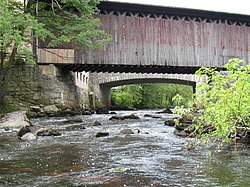Contoocook Railroad Bridge
|
Hopkinton Railroad Covered Bridge
|
|
 |
|
| Location | Off NH 103 and NH 127 Hopkinton, New Hampshire (village of Contoocook) |
|---|---|
| Coordinates | 43°13′23″N 71°42′51″W / 43.22306°N 71.71417°WCoordinates: 43°13′23″N 71°42′51″W / 43.22306°N 71.71417°W |
| Built | 1849-50, rebuilt 1889 |
| Architectural style | Doubled Town lattice truss |
| NRHP Reference # | 80000294 |
| Added to NRHP | January 11, 1980 |
The Contoocook Railroad Bridge is a covered bridge on the former Contoocook Valley (first Concord & Claremont, later Boston & Maine) Railroad line spanning the Contoocook River in the center of the village of Contoocook, New Hampshire, United States. It is referred to in the National Register of Historic Places as the Hopkinton Railroad Covered Bridge, for the town of Hopkinton, New Hampshire, in which the village of Contoocook is located.
Built in the 19th century, it is the oldest extant covered railroad bridge in the United States and served rail traffic until 1960. It was used as a warehouse until 1989, then became public property, and has been preserved by the state, donations, and volunteers, in association with the nearby historic railroad depot.
Built in 1889 to replace a lighter covered railroad bridge constructed between 1849–50, having been built by the former Concord and Claremont Railroad (acquired by the Boston & Maine Railroad in 1887), the bridge is the oldest of four surviving double-web Town lattice railroad bridges, and is the oldest extant covered railroad bridge in the United States. (The others double Towns are Pier Bridge, Newport, New Hampshire, 1907; Wright's Bridge, Newport, NH, 1906; and Fisher Bridge, Stowe, Vermont, 1908.) It was probably designed by Boston & Maine Railroad engineer Jonathan Parker Snow (1848–1933) and built by carpenter David Hazelton (1832–1908). Under Snow, the Boston & Maine utilized wooden bridges on its branch lines longer than any other major railroad, the last of these constructed in 1916. The nearby Contoocook Railroad Depot was built in 1850 on the earlier Concord & Claremont Railroad.
The bridge presents the clearest, most original structure of its type, as the others incorporate significant structural modifications. The main trusses are double Town lattice and are continuous over a central pier to form two spans of approximately 71 feet (22 m) each. It has been often said they were built by the mile and cut off by the yard. The center pier is skewed to match the river flow, as are the abutments. This is because the bridge spans the river on a bias.
...
Wikipedia


